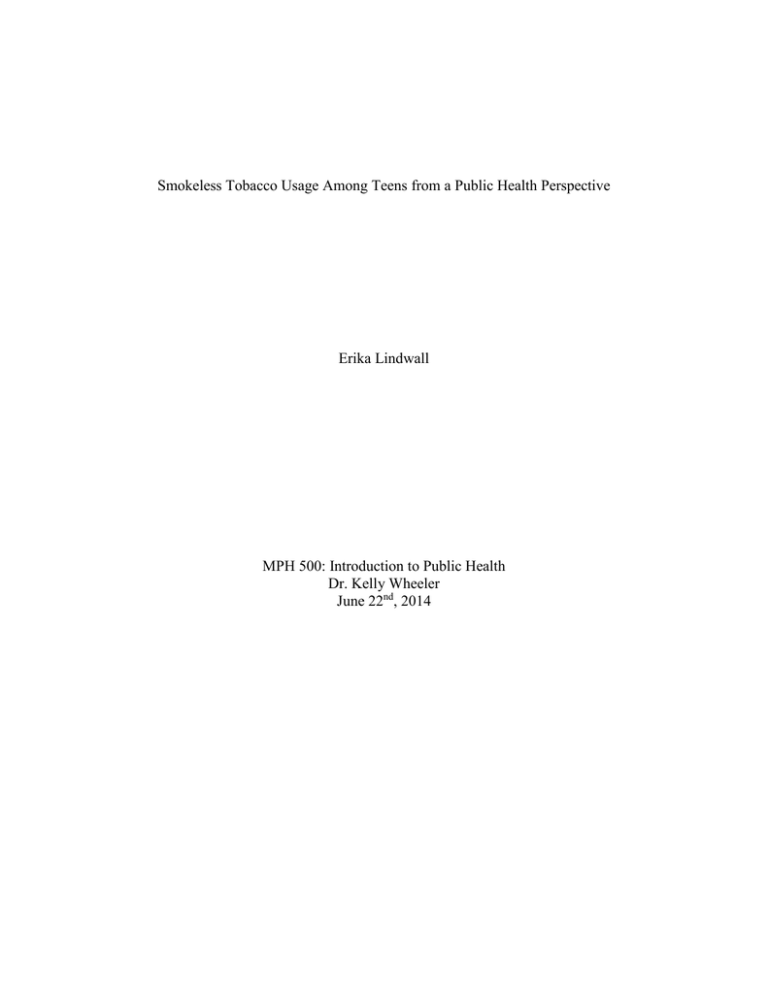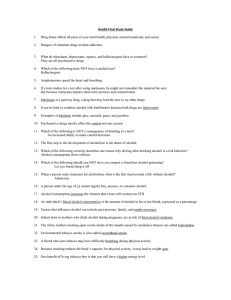Biostatistics of STPs in Teen Population
advertisement

Smokeless Tobacco Usage Among Teens from a Public Health Perspective Erika Lindwall MPH 500: Introduction to Public Health Dr. Kelly Wheeler June 22nd, 2014 INTRODUCTION Using tobacco is detrimental to one’s health. This is a fact that has become commonplace in recent years. Chronic tobacco usage has been linked to health problems like lung cancer, esophageal cancer, oral cancer, heart disease, and atherosclerotic peripheral vascular disease (hardening of the arteries) (CDC, 1999). The harmful effects of tobacco have been made known to the public through ads, awareness programs in schools, and even labels on tobacco cartridges themselves (“The Real Cost” campaign, “Truth” campaign). Because of this higher awareness, there has been a decrease in cigarette smoking among adolescents and teens (Agaku et al., 2013). However, the same cannot be said for usage of smokeless tobacco products (STPs) in the same demographic. In fact, the rate of STP usage among teens in the United States has been unchanged in the last decade. Recent surveys put the number of smokeless tobacco users among teens to be between 5-11% (Agaku et al., 2013; American Cancer Society, 2013). That percentage is more than 9 million adolescents in the United States. Smokeless tobacco has become a widely socially acceptable substitute to cigarettes since it is more discreet and does not pose any harm to others from second hand exposure (Agaku et al., 2013). Furthermore, there may be a perceived lower risk associated with STPs This perception is untrue. According to the American Cancer Society (2013), usage of the any STPs (chewing tobacco, snuff, snus) carry increased risks for mouth, stomach, and pancreatic cancer, heart disease, heart attack and stroke, mouth sores and tooth decay. Because of the risk factors associated with tobacco use to a large amount of the population of American teens, smokeless tobacco usage is a public health concern. To understand the issue from a public health perspective, certain key subjects will be analyzed. The first is epidemiology, where the risk factors and distribution of the condition will be looked at in detail. Then the biomedical basis, biostatistics, and environmental and social factors will be presented. Finally, a look into how the government is addressing the usage of smokeless tobacco products among teens will show how the health of this demographic could improve in the future. BIOSTATISTICS Biostatistics play an important role in understanding the extensive data collected on this subject. By analyzing the biostatistics on STP use among teens, the health risks, vulnerable demographics, and best ways to decrease the widespread use can be determined. In this section, the statistics surrounding the usage of smokeless tobacco will be discussed in detail. Much data about the health risks associated with smokeless tobacco has been collected over the years. One of the major health risks is oral cancer. The biostatistics collected on the prevalence of oral cancer have provided insightful information on cause and effect with smokeless tobacco use. According to the Oral Cancer Foundation (2014), 43,250 Americans are diagnosed with oral cancer every year, causing approximately 8,000 deaths yearly. Smokeless tobacco is a known cause of oral cancer (American Cancer Society, 2013). In fact, there are 28 carcinogens found in smokeless tobacco products (WHO, 2007). STP users have an 80 percent higher risk of oral cancer and a 60 percent higher risk of pancreatic and esophageal cancer. These statistics illustrate the danger smokeless tobacco poses to those who use it. Biostatics are also helpful in understanding what demographics are most at risk for using STPs. According to an extensive study conducted by Boyd (1987), who surveyed 40,000 students, the populations at risk for smokeless tobacco use are mostly males of white, Native American, and Hispanic decent. Rates of usage were lowest among black and Asian males as well as females of white, black, and Hispanic decent. Rates of usage were higher among Native American males and females. This is most likely due to cultural practices that involve tobacco products (Boyd, 1987). The findings of Boyd (1987) are supported by the findings of a more recent study. In an article by Eaton et al. (2006), it was found that 13.6% of male high school students used STPs. 10.2% of those were white, 5.1% were Hispanic, and 1.7% were African American. These finding show that the most vulnerable populations for smokeless tobacco usage among teens are white and Hispanic males. By using the biostatics that demonstrate the health concerns and populations at risk, public health workers can develop targeted programs for education and research. Furthermore, these statistics provide knowledge to the government on the severity of the current smokeless tobacco situation and how many people are at risk of the health conditions associated with its use. Armed with this knowledge, the government, in tandem with the public health field, can devise a solution to the high usage of STP usage among teens. REFERENCES: Agaku, I., Ayo-Yusuf, O., Vardavas, C., Alpert, H., & Connolly, G. (2013). Use of conventional and novel smokeless tobacco products among US adolescents. Pediatrics, 132(3), e578e586. Retrieved from http://pediatrics.aappublications.org/content/132/3/e578.full.pdf+html American Cancer Society. (2013). Smokeless Tobacco. Tobacco and Cancer. Retrieved from http://www.cancer.org/cancer/cancercauses/tobaccocancer/smokeless-tobacco American Heart Association. (2014). Arrhythmia and Heart Failure. Conditions. Retrieved from:http://www.heart.org/HEARTORG/Conditions/Conditions_UCM_001087_SubHo mePage.jsp Ashley, D., O'Connor, R., Bernert, J., Watson, C., Polzin, G., Jain, R., & ... McCraw, J. (2010). Effect of differing levels of tobacco-specific nitrosamines in cigarette smoke on the levels of biomarkers in smokers. Cancer Epidemiology, Biomarkers & Prevention: A Publication Of The American Association For Cancer Research, Cosponsored By The American Society Of Preventive Oncology, 19(6), 1389-1398 Boyd, G. (1987). Use of smokeless tobacco among children and adolescents in the United States. Preventive Medicine, 16(3), 402-421. Champion, V.L., & Skinner, C.S. (2008). The health belief model. Health Behavior and Health Education: Theory, Research, and Practice. San Francisco: Jossey-Bass. 45-65. Chassin, L., Presson, C., Sherman, S., & Margolis, S. (1988). The social image of smokeless tobacco use in three different types of teenagers. Addictive Behaviors, 13(1), 107-112. Center for Disease Control and Prevention, Office on Smoking and Health, & Center for Chronic Disease Prevention and Health Promotion. (1999). Achievements in Public Health, 19001999: Tobacco Use -- United States, 1900-1999. Morbidity and Mortality Weekly Report, 48, 986-993. Retrieved from http://www.cdc.gov/mmwr/preview/mmwrhtml/mm4843a2.htm Center for Disease Control and Prevention. (2012). Youth and Tobacco Use. Smoking and Tobacco Use. Retrieved from http://www.cdc.gov/tobacco/data_statistics/fact_sheets/youth_data/tobacco_use/ Center for Disease Control and Prevention. (2013). Youth and Tobacco Product Use Among Middle and High School Students — United States, 2011 and 2012. Morbidity and Mortality Weekly Report. 62(45):893–7. Dugdale, D. (2012). Nicotine and tobacco: MedlinePlus Medical Encyclopedia. U.S National Library of Medicine. Retrieved from http://www.nlm.nih.gov/medlineplus/ency/article/000953.htm Eaton, D. K., Kann, L., Kinchen, S., Ross, J., Hawkins, J., Harris, W. A., & ... Centers for Disease Control and Prevention. (2006). Youth Risk Behavior Surveillance--United States, 2005. Morbidity and Mortality Weekly Report. Surveillance Summaries. Volume 55, Number SS-5. Centers For Disease Control And Prevention. Hecht, S., & Hoffmann, D. (1988). Tobacco-specific nitrosamines, an important group of carcinogens in tobacco and tobacco smoke. Carcinogenesis, 9(6), 875-884. Lawler, T. S., Stanfill, S. B., Zhang, L., Ashley, D. L., & Watson, C. H. (2013). Chemical characterization of domestic oral tobacco products: Total nicotine, pH, unprotonated nicotine and tobacco-specific N-nitrosamines. Food & Chemical Toxicology, 5(7), 380386. National Center for Chronic Disease Prevention and Health Promotion (US) Office on Smoking and Health. (2012). Social, Environmental, Cognitive, and Genetic Influences on the Use of Tobacco Among Youth. Preventing Tobacco Use Among Youth and Young Adults: A Report of the Surgeon General. 4. Retrieved from: http://www.ncbi.nlm.nih.gov/books/NBK99236/ Nichols, V. (1988). Webster's Dictionary (ed.). Baltimore: Harbor House Publishers. Oral Cancer Foundation. (2014). Oral Cancer Facts. - The Oral Cancer Foundation. Retrieved from http://www.oralcancerfoundation.org/facts/ Oral Health America. (2014). National Spit Tobacco Education Program. Retrieved from http://oralhealthamerica.org/programs/nstep/ Oregon Research Institute. (2014). “What is My Last Dip.” My Last Dip. Retrieved from http://mylastdip.com/ Richter, P., & Spierto, F. W. (2003). Surveillance of smokeless tobacco nicotine, pH, moisture, and unprotonated nicotine content. Nicotine & Tobacco Research, 5(6), 885-889. Schneider, M. (2014). Introduction to Public Health (ed. 4.). Burlington: Jones and Bartlett Learning. 95-119. Stepanov, I., Villalta, P., Knezevich, A., Jensen, J., Hatsukami, D., & Hecht, S. (2010). Analysis of 23 polycyclic aromatic hydrocarbons in smokeless tobacco by gas chromatographymass spectrometry. Chemical Research In Toxicology, 23(1), 66-73. Texas A&M AgriLife Extension Service. (2013). Don’t be a Dip. Retrieved from http://dontdip.tamu.edu/index1.html Through with Chew. (2014). “Our Programs.” Through with Chew. Retrieved from http://www.throughwithchew.com/ Timberlake, D., & Huh, J. (2009). Demographic profiles of smokeless tobacco users in the U.S. American Journal Of Preventive Medicine, 37(1), 29-34. Tomar, S., & Henningfield, J. (1997). Review of the evidence that pH is a determinant of nicotine dosage from oral use of smokeless tobacco. Tobacco Control, 6(3), 219-225. World Health Organization. (2007). Smokeless Tobacco and Some Tobacco-specific Nnitrosamines . IARC Monographs on the Evaluation of Carginogenic Risks to Humans. Lyon: International Agency for Research on Cancer. 57-70.




